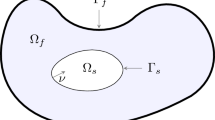Viscous fluid-structure interaction is treated with an arbitrary Lagrangian- Eulerian formulation. The spatial discretization is performed by the spectral element method for the fluid part where the Navier-Stokes equations are integrated and in the solid part where transient linear elasticity is described by the Navier equations. Time marching algorithms are second-order accurate in time in both the fluid and the solid. The algorithm is applied to the flow in a plane channel partially obstructed by a solid component able to move under the action of the fluid flow.
Similar content being viewed by others
References
Formaggia L., Gerbeau J.-F., Nobile F., Quarteroni A. (2001). On the coupling of 3D and 1D Navier–Stokes equations for flow problems in compliant vessels. Comput. Meth. Appl. Mech. Engrg. 191, 561–582
Le Tallec P., Mouro J. (2001). Fluid-structure interaction with large structural displacement. Comput. Meth. Appl. Mech. Engrg. 190, 3039–3067
Ramaswamy B., Kawahara M. (1987). Arbitrary Lagrangian-Eulerian finite element method for unsteady, convective, incompressible viscous free surface fluid flow. In: Gallagher R.H., Glowinsky R., Gresho P.M., Oden J.T., Zienkiewicz O.C. (eds). Finite Elements in Fluids-Volume 7. John Wiley and Sons Ltd., New York, pp. 65–87
Blom F. (1998). Investigation on computational fluid-structure interaction, Ph.D. n 1865, EPFL, Lausanne
Glowinski R., Pan T.-W., Periaux J. (1994). A ficticious domain method for Dirichlet problem and applications. Comput. Meth. Appl. Mech. Engrg. 111, 283–303
De Hart J., Peters G.W.M., Schreurs P.J.G., Baaijens F.P.T. (2000). A two-dimensional fluid-structure interaction model of the aortic valve. J. Biomech. 33, 1079–1088
Causin P., Gerbeau J.F., Nobile F., (2005). Added-mass effect in the design of partitioned algorithms for fluid-structure problems. Comput. Methods Appl. Mech. Engrg. 193, 4073–4095
Ho L.-W., Patera A.T. (1990). A Legendre Element Method for Simulation of Incompressible Unsteady Viscous Free-surface Flows. Comput. Methods Appl. Mech. Engrg. 80, 355–366
Deville M.O., Fischer P.F., Mund E.H. (2002). High-Order Methods for Incompressible Fluid Flow. Cambridge University Press, Cambridge
Widlund O.B., Pavarino L.F. (1999). Iterative substructuring methods for spectral element discretizations of elliptic systems.II: mixed methods for linear elasticity and Stokes flow. SIAM J. Numer. Anal. 37(2): 375–402
Casadei F., Gabellini E., Fotia G., Maggio F., Quarteroni A. (1993). A mortar spectral/finite element method for complex 2D and 3D elastodynamic problems. Comput. Meth. Appl. Mech. Engrg. 104, 49–76
Donea J., Guiliani S., Halleux J.P. (1982). An arbitrary Lagrangian-Eulerian finite element method for transient dynamic fluid-structure interactions. Comput. Meth. Appl. Mech. Engrg. 33, 689–723
Formaggia L., Nobile F. (2004). Stability analysis of second-order time accurate schemes for ALE-FEM. Comput. Methods Appl. Mech. Engrg. 193, 4097–4116
Boffi D., Gastaldi L. (2004). Stability and geometric conservation laws for ALE formulations. Comput. Methods Appl. Mech. Engrg. 193, 4717–4739
Maday Y., Patera A.T. (1989). Spectral element methods for the Navier-Stokes equations. In: Noor A.K., Oden J.T. (eds). State-of-the-Art Surveys in Computational Mechanics. ASME, New York, pp. 71–143
Couzy W., Deville M.O. (1994). Spectral-element preconditoners for the Uzawa pressure operator applied to incompressible flows. J. Sci. Comput. 9, 107–112
Perot J.B. (1993). An analysis of the fractional step method. J. Comp. Phys. 108, 51–58
Curnier A. (1993). Méthodes numériques en mécanique des solides. Presses polytechniques et universitaires romandes, Lausanne
Dubois-Pèlerin Y., Van Kemenade V., Deville M.O. (1999). An Object-Oriented Toolbox for Spectral Element Analysis. J. Sci. Comput. 14, 1–29
Farhat C., Lesoinne M. (2000). Two efficient staggered algorithms for serial and parallel solution of three-dimensional nonlinear transient aeroelastic problems. Comput. Meth. Appl. Mech. Engrg. 182, 499–515
Author information
Authors and Affiliations
Rights and permissions
About this article
Cite this article
Bodard, N., Deville, M.O. Fluid-Structure Interaction by the Spectral Element Method. J Sci Comput 27, 123–136 (2006). https://doi.org/10.1007/s10915-005-9031-2
Received:
Accepted:
Published:
Issue Date:
DOI: https://doi.org/10.1007/s10915-005-9031-2




